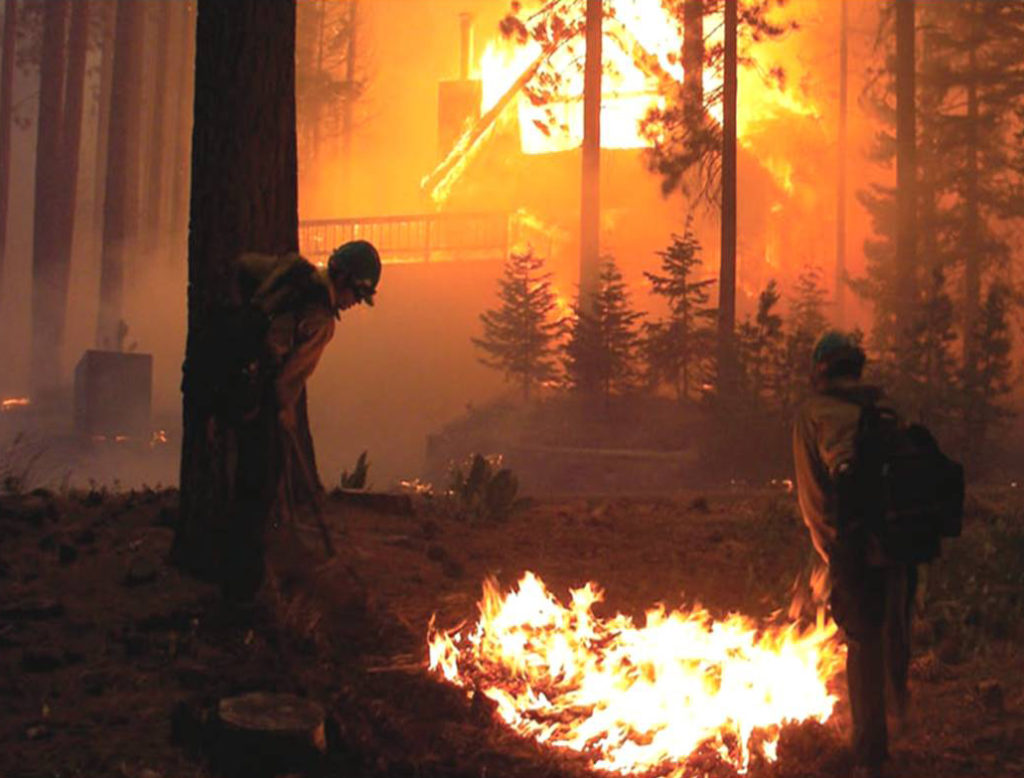Debunking Wildfire Myths
August 16th, 2016
Most homes are destroyed during wildfire by burning embers landing on, in or near the house on something easy to ignite. In this photograph, embers have ignited the house and started several spot fires in the pine needle litter. Photograph courtesy of North Lake Tahoe Fire Protection District.
Have you scrutinized your homeowner’s insurance policy to confirm that you are not underinsured if a wildfire destroys your home? OR did you know that a majority of homes destroyed during wildfire are from embers that can travel up to a mile away from a fire? As a relatively new employee with the Living With Fire Program, I am still learning new things! Some misconceptions continue to surprise me. The following is a list of four common misconceptions I hear regarding wildfire. Read on and be prepared to be debunked!
- Myth 1: If a wildfire destroys my home, my insurance will build me a new home.
Let’s say an individual’s home is destroyed by wildfire. Most homeowners expect their insurance will help them recover from the fire by providing enough money to replace anything damaged or destroyed. According to an expert I spoke with at the Nevada Division of Insurance, a majority of homeowners are under insured or don’t fully understand their insurance coverage. Of the many possible examples, let’s use the car as an example. Say a homeowner is evacuated due to a wildfire, but must leave one car behind parked in the garage and both the car and house are destroyed. The car is not covered by homeowners insurance, and is only covered if the owner has comprehensive auto insurance. This is but one of the many situations to review under your homeowner’s insurance policy. Remember, different insurance companies offer different policies. Due to this wide variation, homeowners should review policy details with their agent or at the very least, thoroughly read their annual policy. For an overview of homeowner’s insurance, please review the Nevada Consumer’s Guide for Home Insurance published by the State of Nevada Department of Business and Industry Division of Insurance, http://doi.nv.gov/uploadedFiles/doinvgov/_public-documents/News-Notes/HomeInsuranceGuide2011B.pdf .
- Myth 2: Firefighters will save my home during a wildfire.
The unfortunate reality of wildfire is there’s no guarantee that firefighters will be able to save your home. It’s projected that the wildfire threat in the Western United States will continue to increase. Since 1991, more than half of the new homes built were in wildland areas and are easily-ignitable, according to the research firm Headwaters Economics in Montana. The US Forest Service estimates that 15 million homes in the U.S. are at risk of being destroyed by wildfire. Unfortunately there will never be enough resources to protect every single home during a large wildfire incident. However, a home with defensible space, appropriate home construction and routine maintenance can increase a home’s survivability. An even greater impact is a “Fire Adapted Community,” or a community of people who work together to reduce the wildfire threat and prepare in advance to survive wildfire. This is a community that is adapted to survive wildfire with little or no assistance from firefighters. View the Fire Adapted Communities publication to help reduce the wildfire threat. http://www.unce.unr.edu/publications/files/nr/2011/sp1101.pdf#search="fire adapted communities"
-Myth 3: During a wildfire, I’ll defend my home using my lawn sprinklers and a garden hose.
I’ve actually heard a neighbor say this one to me. During a wildfire, running yard sprinklers or water from your hose bib outdoors can affect crucial water pressure that’s necessary for firefighters to combat the fire. Conversely, because the firefighters are using the water supply, there might not be enough pressure to even power sprinklers or a hose. Another reason why one shouldn’t rely on their yard’s watering equipment to fight a wildfire is the possibility of no water at all. If the electricity is out, a home’s water source might not work due to electrical pump failure. When evacuating a home during a wildfire, it is recommended that homeowners connect garden hoses to outdoor faucets so firefighters can have access to them if necessary, but don’t leave the water running. For more tips on safe evacuation during a wildfire, see the evacuation information at http://www.livingwithfire.info/during-the-fire
- Myth 4: Direct contact with the wildfire flame front is why most homes are destroyed.
We’ve all seen the news footage of a wildfire where a huge wall of orange flames rush in to threaten a home. Contrary to popular belief, most homes do not ignite from direct contact with flame front. Most homes, an estimated 90%, are destroyed from embers. Depending on fire intensity, wind speed and the size of burning materials, embers can travel more than a mile away from the fire. These embers can become lodged in something easily ignited on, in or near the house, eventually starting a small fire which can grow and destroy the home. Proper attention to these vulnerable, easily-ignited areas of the home helps to decrease the home’s risk to being destroyed by wildfire. Check out the Be Ember Aware publication to identify these vulnerable spots at http://www.unce.unr.edu/publications/files/nr/2009/fs0905.pdf#search="be ember aware"

Jamie Roice-Gomes
Jamie Roice-Gomes is the outreach coordinator with University of Nevada Cooperative Extension’s Living with Fire Program. She earned her Bachelor of Science in Wildlife Ecology and Conservation and a Master of Arts in Interactive Environmental Journalism. She was a public relations assistant for Conrad Communications, a public information officer intern at the Nevada Department of Conservation & Natural Resources, and a Biological Science Technician at the USDA-Agriculture Research Service. She also enjoys volleyball, the Great Basin Desert, and spending time with family. Contact Jamie at 775-336-0261 or roicej@unce.unr.edu.
